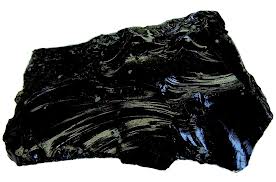I have really enjoyed this Introduction to Geology course so far. Now, given the occasion to discuss minerals and rocks, I will be able to identify my favorite. In regards to the minerals, galena captured my interest the most. For the rock category, Obsidian was my favorite. I would like to use this blog post to explain some characteristics of each.
Galena
Galena is the natural mineral form of lead sulfide (PbS). The main characteristic that allured me was that galena contains cubic crystals. This particular mineral is fairly common and occurs in numerous locations worldwide including England, Germany, Bulgaria, Romania, and Kosovo (a part of former Yugoslavia!—- no wonder I was attracted to this mineral!) (The Mineral Galena).
So apart form its beauty due to luster, how is this mineral used? Well, in ancient Egypt, galena was applied around the eyes to help both reduce the glare of the desert sun and repel flies. More currently, Galena serves as an important mineral because it serves as an ore for most of the world’s lead production. In addition, Galena is also a significant ore of silver (King). “The number one use of lead today is in the lead-acid batteries that are used to start automobiles” (King).
Now…. on to my favorite rock…… (I admit it… I fall for looks)…..
Obsidian
Obsidian, an extrusive igneous rock, can be referred to as volcanic glass; its glassy appearance is the result of rapidly cooled volcanic lava. In other words, the lava cooled so rapidly that atoms are unable to arrange themselves into a crystalline structure. In regards to its color, Black is the most common color of obsidian; nonetheless, it can also be brown or green (Obsidian: Igneous Rock). As a “glass”, obsidian can be considered “chemically unstable.” This means that, “[w]ith the passage of time, some obsidian begins to crystallize” (Obsidian: Igneous Rock). This process of crystallization does not happen at a constant/uniform rate throughout the rock— instead, the process is much more random as the chemical change begins at various locations within the rock.
Geographically speaking—like Galena– obsidian is found in a wide variety of locations worldwide. It tends to be “confined to areas of geologically recent volcanic activity. Obsidian older than a few million years is rare because the glassy rock is rapidly destroyed or altered by weathering, heat or other processes” (Obsidian: Igneous Rock). In the United States, Obsidian can be found in Arizona, California, Idaho, Nevada, New Mexico, Oregon, Washington, and Wyoming (Obsidian: Igneous Rock).
Interestingly, due to fracturing patterns—-more specifically, conchoidal fracturing— obsidian can be used to create ultra-thin blades with tips that can be as narrow as 3 nanometers (Obsidian: Igneous Rock). Such thin blades can be useful for creating extremely precise incisions. This “easy to recognize” rock was one of the first targets of organized mining during the stone age; “it is probably a safe bet that all natural obsidian outcrops that are known today were discovered and utilized by ancient people” (Obsidian: Igneous Rock). While this material has been used since the stone age, it continues to play a very important role in modern surgery.
Works Cited:
“Obsidian: Igneous Rock.” Web. 31 Mar. 2013. .
“The Mineral Galena: Information and Pictures.” Web. 31 Mar. 2013. .
King, Hobart. “Galena: Mineral.” Web. 01 Apr. 2013. .


